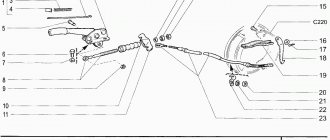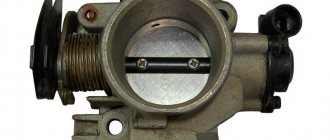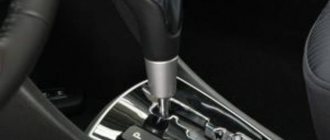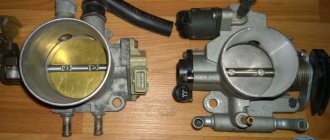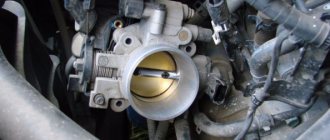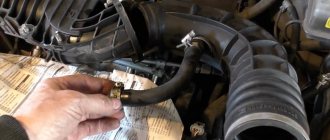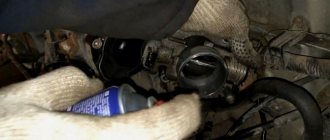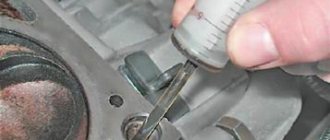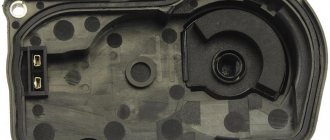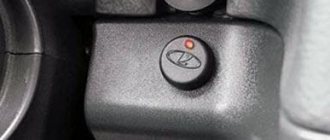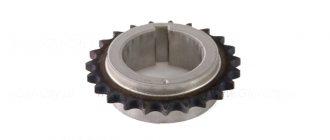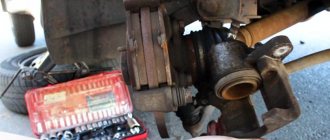Flushing the throttle assembly and valve is not a difficult task. But many car owners do not know how to clean, why and when, and, having little experience in car maintenance, are afraid to climb under the hood and do anything with their own hands.
In this article we will analyze the entire procedure for flushing the throttle assembly, and I hope that the typical car owner will no longer have all the questions about performing this operation.
Where is the DZ located?
Engine compartment
The entire throttle body is located in the engine compartment. It is located between the intake manifold and the air filter. In other words, the air enters the filter, passes through the mass air flow sensor, enters the remote control, and from there goes to the engine through the intake manifold (receiver). To find out where the remote control is located, pay attention to the figure (number 3).
Electronic gas pedal
On some modifications of the VAZ-2110, the throttle valve is driven by an electric motor. The idea is simple: a sensor system is installed on the pedal (most often based on a potentiometer - a variable resistor). When you press the pedal, the resistance changes, and the electronic control unit determines the position based on the signal level. Then a signal is sent to the throttle valve actuator, and it opens to a certain angle. Instead of rheostats, encoders are installed - sensors that record the angular movement of the axis. They are more accurate and reliable, but the cost is higher. In general, the reliability of an electronic damper drive is much higher than a cable drive.
Signs of a dirty remote control
The most common symptoms associated with a dirty damper:
- Poor engine starting.
- Unstable idling, speed fluctuates.
- The car jerks when driving at low speeds.
- Difficulty idling, engine stalls.
All these signs indicate a dirty remote control. But do not rush to draw conclusions and start cleaning the unit, because they may also indicate a breakdown of some sensors: IAC, TPS - they are located on the throttle assembly and may be faulty. In particular, high-quality washing of the remote control can cure them, but not a fact (by following the link, you can check, clean, replace the IAC, check the TPS, repair and replace it). A faulty mass air flow sensor also has similar symptoms. It is advisable to clean the remote control at intervals of 30 thousand km.
Normal operation
Air enters through the gap formed by the damper, but the regulator does not work. A mixture formation process occurs in the fuel rail - gasoline is suspended (like fog) under high pressure. Its value is constant and is regulated using a sensor and an overpressure valve. After the mixture is formed, fuel is injected into the combustion chambers - the injectors open one by one (in fact, these are electromagnetic valves). They are controlled by an electronic unit. Their operation completely depends on the readings of the sensors and the fuel map (firmware of the microcontroller control system).
Flushing the remote control
In this article we will describe two types of DS cleaning:
- Surface.
- Full.
They differ in the degree of complexity and, accordingly, in quality.
Superficial cleaning
Its essence is that we will not completely disassemble the entire remote control, but will go over the damper with a cloth and remove surface dirt.
For work we will need:
- Any cleaning agent: carburetor cleaner, alcohol, thinner, gasoline, wd-40. They differ in the degree of “removability” of dirt.
- Rag.
- Brush.
First of all, we remove the air filter corrugation from the air filter, take our cleaning agent and spray it inside. We begin to clean the surface with a rag and brush. Also, do not forget to open the damper itself and clean it from the back. At this point the process is completed, we install the filter pipe back, and that’s it. But with this cleaning method, we will not be able to completely clean all the insides of the remote control, blow out all the holes and channels, so it is better to use a complete cleaning.
Complete cleaning of the remote control
To perform a complete cleaning of the damper, in addition to a rag and cleaning agent, we will need:
- Flathead, Phillips screwdriver.
- DZ gasket (for 1.5 l) and receiver o-ring (for 1.6 l).
- Cotton buds.
- Socket wrench set to "13".
- 2 M13 bolts.
In this case, we need to completely remove the remote control and clean it from all sides.
- In order to remove the unit, disconnect the air filter corrugation and remove the coolant pipes. liquid and adsorber.
- Disconnect the remote control mount, remove the throttle cable, and remove the remote control. If you need a more detailed description of removing the unit, then read the article: How to remove the remote control, remote control?
- Having removed the DZ, we disconnect and clean the IAC sensors (how to clean the IAC), TPS and completely wash the damper on all sides with a cleaner, be sure to blow out all the holes with compressed air.
- Then we install everything back, not forgetting to put in a new gasket.
Removing the throttle valve
Unscrewing the damper fasteners
In order to remove the mechanism, arm yourself with screwdrivers, which will be needed when freeing the mechanism from the clamps, a 13mm socket wrench, and any cleaning agent.
- Cleaning the described unit of a VAZ car begins with removing the plastic lining covering the upper part of the power unit;
- After this, remove the hose that provides forced ventilation. Look at the condition of the air pipe, as there may be oil residues there, which indicates that the mechanism also requires cleaning;
- Next, remove the cap that covers the expansion tank to eliminate pressure in the engine cooling system, since the damper is connected to the anti-freeze hoses. To do this, you need to remove the hoses that heat the mechanism, after first removing the fastening clamps from them. The pipe system is closed with easily removable plugs;
- And finally, we remove the hose with which the fuel tank is ventilated, disconnect the cable that connects the damper to the gas pedal and remove the device itself. To do this, you need to unscrew the two fastening nuts.
Depending on the degree of contamination, either superficial or complete cleaning of the mechanism is necessary.
Step-by-step cleaning instructions
If the damper does get dirty, it doesn’t matter; with the help of several cleaning steps, the car’s operation will be restored. Before cleaning, you must remove the throttle assembly according to the following instructions:
- remove the corrugation;
- turn off the power supply to the sensors;
- push out the “weight” that secures the pedal cable;
- disconnect the coolant pipe;
- remove the ventilation hose; unscrew the assembly fastening;
- Unscrew the idle speed control.
To clean mechanisms, special products are required, in most cases aerosol cans. The best solution for this task is a carburetor or brake cleaner.
TUNING WITH REPLACEMENT
The standard valve (throttle assembly) usually has a diameter of 46 millimeters; many fans of various tunings decide to replace this part with an alternative one:
- VAZ 2112 throttle valve 52 has a larger diameter (there are also valves of 54 and 56 millimeters)
- Is there any benefit from such tuning?
- In various online stores they often offer to replace the standard 46 mm throttle body (DU) and install 52, 54 or 56 mm
- The product description says that an enlarged throttle body (also known as the throttle body) leads to a decrease in air flow speed, which improves the performance of the air intake system
- The effect of installing an alternative damper will be clearly visible when using a zero-resistance filter in the system
- We recommend installing a unit with a diameter of 52mm, because... the diameter of its air inlet for a standard receiver is 53mm
The valve is standard (standard) on the left and new (increased flow diameter) on the right
- In order to install a remote control of a different diameter, as a rule, nothing needs to be modified
- The maximum necessary action is a small trimming of the gasket (this is most often necessary when installing a 56mm throttle assembly)
The following positive effects are noticed after such an installation:
- The car becomes more agile
- Problems with idle speed disappear
- The gas pedal also becomes more responsive.
Installation disadvantages:
- Fuel consumption increases, although many believe that the BC gives incorrect readings and consumption does not change
- Some owners see the effect exclusively on 16-valve engines
The picture we described above may appear completely different:
- All the positive effect that many people notice when installing a larger diameter remote control usually appears because the old remote control already needed cleaning and naturally the motor was not working correctly
- After installing a (clean) new remote control, the engine starts working in its normal mode, this seems like a “new breath”
- In other words, all the described effects appear after regular cleaning of the remote control.
- And besides this, after replacing the remote control, with a larger diameter you will have new problems with the operation of the motor that did not exist before
- This is due to a violation of the ratio of gasoline and air, which the ECU is no longer able to correct.
- And instead of simply returning the remote control to the standard diameter, the owners are recommended to replace the firmware, the price of which is higher, but there is no point
- There is also an opinion that a remote control with a diameter of 52, 54 or 56 millimeters is a completely useless thing, and only installed in combination with other engine tunings produces a noticeable effect
- It remains unclear whether this effect is caused by remote control or other modifications to the engine
- After all, if on a turbo engine with a power of no more than 200 horsepower, standard 46mm dampers are left and their work is quite enough
LET'S SUM UP
| Supporters of replacing the remote control with a different diameter argue | Opponents of replacing the remote control with a different diameter argue |
| Replacement increases power and improves engine speed and gas pedal responsiveness | Washing or repairing a standard remote control gives similar effects |
| Does not affect gas mileage | Affects gas mileage, as everything is interconnected |
| Does not create problems in engine operation | Creates problems because the ECU cannot correctly adjust the ratio of air and gasoline in the mixture |
| Problems that arise can be solved with firmware | Problems are solved by flushing |
| Clearly, all tangible effects are associated with changing the remote control and are enhanced in combination with other improvements | Tangible effects are achieved by flushing the unit, and the use of other improvements improves the performance of the engine without replacing the remote control |
Here everyone decides for himself, we will not enter into disputes, there are simply different opinions, and we are obliged to warn about the pitfalls and the other side of the coin.
